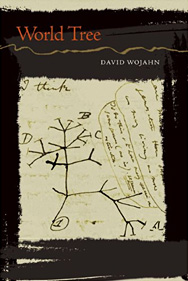DAVID WOJAHN
David Wojahn’s Introduction to “Ochre"
A Suite of Twenty–five Poems and Accompanying Images
|
Ochre Table of Contents Or click the previous / next control from either a text or full image view to go back to the previous poem or advance to the next. |
|
At one point I half-seriously considered entitling my new collection Dead Formats, although it now bears a slightly better title, World Tree. Again and again, almost unintentionally, the poems seemed to be about modes of communication and art-making that now seem lost to the dustbin of history—cave paintings; anonymous Kodak and Polaroid snapshots; shamanic rituals; 78-, 33 ⅓-, and 45-rpm records; spirit photography, cassettes, IBM Selectric typewriters; WordPerfect, WordStar, printed books. The subject of the book was not so much the stories we tell ourselves or the elegies that console us—although these are always concerns that compel me—but a kind of archaeology of astonishment, our collective amazement at discovering, if you can read the ruins and the shards correctly (and poetry is an immensely useful tool in learning such a skill), there can remain, as the opening section of “Ochre” insists, “something of us to prove our afterlife.”
“Ochre” is one of four sections that make up World Tree. It was inspired by two complimentary forms for visual art: cave paintings, and other examples of Neolithic artifacts, and anonymous photographs from the early part of the twentieth century, many of which were gathered by the great collector of such work, Robert Jackson, and now are part of the collection of the National Gallery of Art.
 |
|
These two varieties of work made for a kind of thematic rhyming that I initially tried to express by alternating sections about the photos with sections about cave art. Each section of the sequence is a sonnet, a form I found especially congenial for expressing this alternation and juxtaposing—rhyming words to compliment the rhyming of the two kinds of subjects that inspired the sequence. As the sequence progressed, the juxtapositions became more troubled and fraught. A poem on one of the earliest depictions of the human figure, the “Killed Man” on the walls of Cougnac Cave—who is depicted bristling with spears—summoned up for me those sadly indelible images of Abu Ghraib Prison. Photos of exquisitely worked Clovis spearpoints—the technology which likely caused the wooly mammoth to go extinct—brought to mind a comic but chilling image of Robert Oppenheimer’s toddler son with his father’s pipe in his mouth; ironically, Los Alamos and the site where the Clovis spearpoints were first discovered are only a stone’s throw away from one another.
As the sequence continued, I also found myself writing about personal photos from my own childhood, images which now seem as distant and strange as the Kodak or the cave-art images. I thought it fitting that a sequence which tries to evidence our collective afterlives should end with the suggestion of some sort of personal afterlife in the form of generational continuity—thus the sequence ends with sections devoted to sonogram images of my sons and a military photo of my father, taken sometime during World War II.
“Ochre” is very much a collective endeavor between myself and the Blackbird staff, who wrangled for photo and image permissions, worked tirelessly on the sequence’s presentation, created original images, and generally worked their butts off on my behalf. ![]()
Introduction
Something of Us to Prove Our Afterlife: Notes on “Ochre”
Table of Contents
Acknowledgements